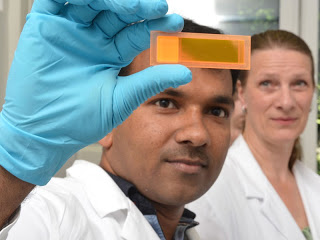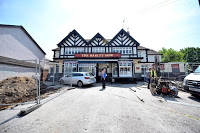Medieval History
 In a development that could have been very useful over six hundred years ago, scientists have discovered a simple and effective way of determining if someone has Yersinia pestis, the bacterium that is responsible for the Black Death. A team based out of the Max Planck Institute in Germany were able to create a sugar-protein that serves as biomarker when tested on the blood of individuals who carry the plague.
In a development that could have been very useful over six hundred years ago, scientists have discovered a simple and effective way of determining if someone has Yersinia pestis, the bacterium that is responsible for the Black Death. A team based out of the Max Planck Institute in Germany were able to create a sugar-protein that serves as biomarker when tested on the blood of individuals who carry the plague.
The Black Death, which swept through the medieval world in the mid-14th century, could infect and kill people within hours. ?Early identification of an infection is of paramount importance for survival,? explains Chakkumkal Anish, Leader of the Glycobiology Research Group at the Max Planck Institute. ?So our work may have direct and positive consequences on patient survival rates.?
While the plague is not ravaging society as it once did, there have been sporadic outbreaks, including in India, China, Libya and New Mexico in recent years. The scientists also believe the process they used to develop this test will be useful with detecting other kinds of diseases.
Click here to read the full details from the Max Planck Institute.
Their exploits would include the "so-called prince of camel thieves, for instance ? one Shaiban bin Shihab ? developed the novel technique of releasing a container filled with voracious camel ticks on the edges of an encampment. When the panicked beasts of burden scattered, he would seize his chance and steal as many as he could. To immobilize any watchdogs in the area, other members of the Banu Sasan would ?feed them a sticky mixture of oil-dregs and hair clippings? ? the contemporary writer Damiri notes ? ?which clogs their teeth and jams up their jaws.?
Click here to read this article from Past Imperfect
 In Birmingham, England, archaeologists are working outside of The Barley Mow pub. The pub owner believes they will find the remains of one of Richard III?s knights. However, a spokesman for the construction company behind the dig is less sure. ?The archaeological investigation has found several 17th century post-medieval rubbish pits," he said.?There is no truth in the suggestion the team were looking for the remains of a follower of Richard III and nothing was found relating to the late medieval period.? You can read more from the Birmingham Mail.
In Birmingham, England, archaeologists are working outside of The Barley Mow pub. The pub owner believes they will find the remains of one of Richard III?s knights. However, a spokesman for the construction company behind the dig is less sure. ?The archaeological investigation has found several 17th century post-medieval rubbish pits," he said.?There is no truth in the suggestion the team were looking for the remains of a follower of Richard III and nothing was found relating to the late medieval period.? You can read more from the Birmingham Mail.
A more promising find has occurred in Heslington, just outside of York. A Roman well, dating from the late fourth to early fifth centuries, has been uncovered, along with more than a 1000 pieces of Romano-British pottery, including two almost complete Huntcliff-type jars, and a similar number of animal bone fragments. Steve Roskams, Senior Lecturer at the University of York said, ?It is striking that all of the material found in our well would have been familiar to those inhabiting this landscape. Its construction incorporates a finial which, we argue, probably came from the dismantling of a nearby, good-quality structure. The jars circulated here widely, the Huntcliff-type probably being connected directly to water usage. The other pottery and the animal bones also comprise well-understood 'mundane' elements that were available locally."
Click here to read the full article from the University of York
Finally, what is new on Youtube for medievalists? There is this video, entitled '5 Of The Most Gruesome Medieval Torture Devices' - please keep in mind that only one of the five torture devices mentioned here - the Rack - was actually used in the Middle Ages. Most of the others are first mentioned in the Early Modern period.
- Medieval Bones Found At York Building Site
Police have been called to a York building site after workmen uncovered human remains believed to come from a medieval cemetery. Fragments of human bones, which were found under a home in the Lawrence Street area, are thought to have come from a cemetery...
- Hunting For A Mass Killer In Medieval Graveyards
Beneath the Royal Mint Court, diagonally across the street from the Tower of London, lie 1,800 mute witnesses to the foresight of the city fathers in the year 1348. Recognizing that the Black Death then scourging Europe would inevitably reach London,...
- Researchers Discover Original Bacteria Of The Black Death
The bacteria responsible for causing the 1348 Black Death, identified as one of the most cataclysmic events in human history, has been identified by researchers from Canada and Germany. Using a novel method of DNA enrichment coupled with high-throughput...
- Archaeologists Discover Byzantine Monastic Complex In Istanbul
The Küçükyal? Arkeopark, a large archaeological area on the Asian side of Istanbul, hosts the only surviving Byzantine monastic complex in the city, the head of the excavation team says. The 9th-century complex contains gorgeous marble floors, valuable...
- Harold Bluetooth's Palace Discovered And Other Medieval Archaeology News
Here are several reports of medieval archaeological finds this month: Royal Palace of Harold Bluetooth Discovered in Denmark Archaeologists from the University of Aarhus in Denmark have discovered a royal palace belonging to Harald Bluetooth, who ruled...
Medieval History
Doctors can now figure out if you have the Black Death; and more medieval news

The Black Death, which swept through the medieval world in the mid-14th century, could infect and kill people within hours. ?Early identification of an infection is of paramount importance for survival,? explains Chakkumkal Anish, Leader of the Glycobiology Research Group at the Max Planck Institute. ?So our work may have direct and positive consequences on patient survival rates.?
While the plague is not ravaging society as it once did, there have been sporadic outbreaks, including in India, China, Libya and New Mexico in recent years. The scientists also believe the process they used to develop this test will be useful with detecting other kinds of diseases.
Click here to read the full details from the Max Planck Institute.
The Banu Sasan Criminal Network
The Smithsonian Institute blog Past Imperfect has a very interesting article on Islam?s Medieval Underworld. It focuses on the Banu Sasan, a loosely organized criminal network that operated throughout many Muslim lands during the Middle Ages. They were thieves, burglars, murderers and con artists, and their activities often got mentioned in Arabic literature.Their exploits would include the "so-called prince of camel thieves, for instance ? one Shaiban bin Shihab ? developed the novel technique of releasing a container filled with voracious camel ticks on the edges of an encampment. When the panicked beasts of burden scattered, he would seize his chance and steal as many as he could. To immobilize any watchdogs in the area, other members of the Banu Sasan would ?feed them a sticky mixture of oil-dregs and hair clippings? ? the contemporary writer Damiri notes ? ?which clogs their teeth and jams up their jaws.?
Click here to read this article from Past Imperfect
More Medieval News
Archaeologists working in the imperial forum area of the city of Rome have uncovered the remains of an 8th-century workshop and a residential area dating to the 14th century. You can read more from ANSA.
A more promising find has occurred in Heslington, just outside of York. A Roman well, dating from the late fourth to early fifth centuries, has been uncovered, along with more than a 1000 pieces of Romano-British pottery, including two almost complete Huntcliff-type jars, and a similar number of animal bone fragments. Steve Roskams, Senior Lecturer at the University of York said, ?It is striking that all of the material found in our well would have been familiar to those inhabiting this landscape. Its construction incorporates a finial which, we argue, probably came from the dismantling of a nearby, good-quality structure. The jars circulated here widely, the Huntcliff-type probably being connected directly to water usage. The other pottery and the animal bones also comprise well-understood 'mundane' elements that were available locally."
Click here to read the full article from the University of York
Finally, what is new on Youtube for medievalists? There is this video, entitled '5 Of The Most Gruesome Medieval Torture Devices' - please keep in mind that only one of the five torture devices mentioned here - the Rack - was actually used in the Middle Ages. Most of the others are first mentioned in the Early Modern period.
- Medieval Bones Found At York Building Site
Police have been called to a York building site after workmen uncovered human remains believed to come from a medieval cemetery. Fragments of human bones, which were found under a home in the Lawrence Street area, are thought to have come from a cemetery...
- Hunting For A Mass Killer In Medieval Graveyards
Beneath the Royal Mint Court, diagonally across the street from the Tower of London, lie 1,800 mute witnesses to the foresight of the city fathers in the year 1348. Recognizing that the Black Death then scourging Europe would inevitably reach London,...
- Researchers Discover Original Bacteria Of The Black Death
The bacteria responsible for causing the 1348 Black Death, identified as one of the most cataclysmic events in human history, has been identified by researchers from Canada and Germany. Using a novel method of DNA enrichment coupled with high-throughput...
- Archaeologists Discover Byzantine Monastic Complex In Istanbul
The Küçükyal? Arkeopark, a large archaeological area on the Asian side of Istanbul, hosts the only surviving Byzantine monastic complex in the city, the head of the excavation team says. The 9th-century complex contains gorgeous marble floors, valuable...
- Harold Bluetooth's Palace Discovered And Other Medieval Archaeology News
Here are several reports of medieval archaeological finds this month: Royal Palace of Harold Bluetooth Discovered in Denmark Archaeologists from the University of Aarhus in Denmark have discovered a royal palace belonging to Harald Bluetooth, who ruled...
